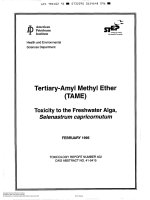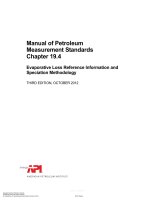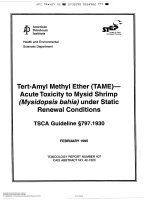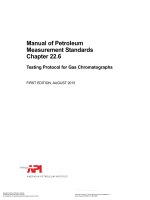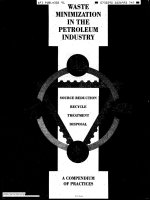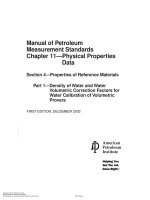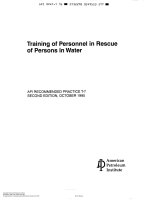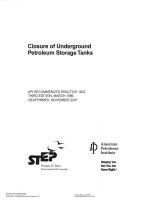Api mpms 10 8 2005 (2010) (american petroleum institute)
Bạn đang xem bản rút gọn của tài liệu. Xem và tải ngay bản đầy đủ của tài liệu tại đây (425.38 KB, 18 trang )
Manual of Petroleum
Measurement Standards
Chapter 10—Sediment and Water
Section 8—Standard Test Method for Sediment in
Crude Oil by Membrane Filtration
SECOND EDITION, NOVEMBER 2005
REAFFIRMED, MARCH 2010
Manual of Petroleum
Measurement Standards
Chapter 10—Sediment and Water
Section 5—Standard Test Method for Sediment in
Crude Oil by Membrane Filtration
Measurement Coordination
SECOND EDITION, NOVEMBER 2005
REAFFIRMED, MARCH 2010
SPECIAL NOTES
API publications necessarily address problems of a general nature. With respect to
particular circumstances, local, state, and federal laws and regulations should be
reviewed.
Neither API nor any of API’s employees, subcontractors, consultants, committees, or
other assignees make any warranty or representation, either express or implied, with
respect to the accuracy, completeness, or usefulness of the information contained herein,
or assume any liability or responsibility for any use, or the results of such use, of any
information or process disclosed in this publication. Neither API nor any of API’s
employees, subcontractors, consultants, or other assignees represent that use of this
publication would not infringe upon privately owned rights.
API publications may be used by anyone desiring to do so. This publication is an
updated version of MPMS Chapter 10.8. Previous editions of this publication were
numbered MPMS Chapter 10.8. Users of this standard should take efforts to ensure they
are using the most current version of this publication. Every effort has been made by the
Institute to assure the accuracy and reliability of the data contained in them; however, the
Institute makes no representation, warranty, or guarantee in connection with this
publication and hereby expressly disclaims any liability or responsibility for loss or
damage resulting from its use or for the violation of any authorities having jurisdiction
with which this publication may conflict.
API publications are published to facilitate the broad availability of proven, sound
engineering and operating practices. These publications are not intended to obviate the
need for applying sound engineering judgment regarding when and where these
publications should be utilized. The formulation and publication of API publications is
not intended in any way to inhibit anyone from using any other practices.
Any manufacturer marking equipment or materials in conformance with the marking
requirements of an API standard is solely responsible for complying with all the
applicable requirements of that standard. API does not represent, warrant, or guarantee
that such products do in fact conform to the applicable API standard.
All rights reserved. No part of this work may be reproduced, stored in a retrieval system,
or transmitted by any means, electronic, mechanical, photocopying, recording, or
otherwise, without prior written permission from the publisher. Contact the Publisher,
API Publishing Services, 1220 L Street, N.W., Washington, D.C. 20005.
Copyright © 2005 American Petroleum Institute
FOREWORD
Nothing contained in any API publication is to be construed as granting any right, by
implication or otherwise, for the manufacture, sale, or use of any method, apparatus, or
product covered by letters patent. Neither should anything contained in the publication be
construed as insuring anyone against liability for infringement of letters patent.
This document was produced under API standardization procedures that ensure
appropriate notification and participation in the developmental process and is designated
as an API standard. Questions concerning the interpretation of the content of this
publication or comments and questions concerning the procedures under which this
publication was developed should be directed in writing to the Director of Standards,
American Petroleum Institute, 1220 L Street, N.W., Washington, D.C. 20005. Requests
for permission to reproduce or translate all or any part of the material published herein
should also be addressed to the director.
Generally, API standards are reviewed and revised, reaffirmed, or withdrawn at least
every five years. A one-time extension of up to two years may be added to this review
cycle. Status of the publication can be ascertained from the API Standards Department,
telephone (202) 682-8000. A catalog of API publications and materials is published
annually and updated quarterly by API, 1220 L Street, N.W., Washington, D.C. 20005.
Suggested revisions are invited and should be submitted to the Standards and
Publications Department, API, 1220 L Street, NW, Washington, DC 20005,
CONTENTS
Page
1. SCOPE ......................................................................................................................... 1
2. REFERENCED DOCUMENTS .................................................................................. 1
2.1 ASTM Standards ................................................................................................ 1
2.2 API Standards ..................................................................................................... 1
2.3 ISO Standard ...................................................................................................... 1
3. SUMMARY OF TEST METHOD............................................................................... 1
4. SIGNIFICANCE AND USE ........................................................................................ 1
5. APPARATUS............................................................................................................... 2
6. REAGENTS ................................................................................................................. 2
7. SAMPLING, TEST SPECIMENS ............................................................................... 2
8. PROCEDURE .............................................................................................................. 3
9. CALCULATION.......................................................................................................... 3
10. REPORT....................................................................................................................... 3
11. PRECISION AND BIAS.............................................................................................. 4
12. KEYWORDS ............................................................................................................... 4
ANNEX A1. SAFETY PRECAUSTIONS TO AVOID STATIC DISCHARGE .............. 4
SUMMARY OF CHANGES.............................................................................................. 5
Figure
1 Membrane Filtration Assembly.................................................................................... 2
Table
1 Precision Intervals ........................................................................................................ 4
iii
An American National Standard
Designation: D 4807 – 05e1
Designation: Manual of Petroleum Measurement Standards (MPMS), Chapter 10.8
Standard Test Method for
Sediment in Crude Oil by Membrane Filtration1
This standard is issued under the fixed designation D 4807; the number immediately following the designation indicates the year of
original adoption or, in the case of revision, the year of last revision. A number in parentheses indicates the year of last reapproval. A
superscript epsilon (e) indicates an editorial change since the last revision or reapproval.
This standard has been approved for use by agencies of the Department of Defense.
e1 NOTE—Footnote 5 was updated editorially in August 2005.
1. Scope*
1.1 This test method covers the determination of sediment
in crude oils by membrane filtration. This test method has been
validated for crude oils with sediments up to approximately
0.15 mass %.
1.2 The accepted unit of measure for this test method is
mass %, but an equation to convert to volume % is provided
(see Note 6).
1.3 The values stated in SI units are to be regarded as the
standard. The values given in parentheses are for information
only.
1.4 This standard does not purport to address all of the
safety concerns, if any, associated with its use. It is the
responsibility of the user of this standard to establish appropriate safety and health practices and determine the applicability of regulatory limitations prior to use. For specific
warning statements, see 6.1 and Annex A1.
D 4177 Practice for Automatic Sampling of Petroleum and
Petroleum Products (API MPMS Chapter 8.2)
D 4865 Guide for Generation and Dissipation of Static
Electricity in Petroleum Fuel Systems
D 5854 Practice for Mixing and Handling of Liquid
Samples of Petroleum and Petroleum Products (API
MPMS Chapter 8.3)
2.2 API Standards:3
MPMS Chapter 8.1 Manual Sampling of Petroleum and
Petroleum Products (ASTM Practice D 4057)
MPMS Chapter 8.2 Automatic Sampling of Petroleum and
Petroleum Products (ASTM Practice D 4177)
MPMS Chapter 8.3 Mixing and Handling of Liquid Samples
of Petroleum and Petroleum Products (ASTM Practice
D 5854)
MPMS Chapter 10.1 Test Method for Sediment in Crude
Oils and Fuel Oils by the Extraction Method (ASTM Test
Method D 473)
2.3 ISO Standard:4
ISO 5272:1979 Toluene for Industrial Use—Specifications
2. Referenced Documents
2.1 ASTM Standards: 2
D 473 Test Method for Sediment in Crude Oils and Fuel
Oils by the Extraction Method (API MPMS Chapter 10.1)
D 4057 Practice for Manual Sampling of Petroleum and
Petroleum Products (API MPMS Chapter 8.1)
3. Summary of Test Method
3.1 A portion of a representative crude oil sample is
dissolved in hot toluene and filtered under vacuum through a
0.45-µm porosity membrane filter. The filter with residue is
washed, dried, and weighed to give the final result.
1
This test method is under the jurisdiction of ASTM Committee D02 on
Petroleum Products and Lubricants and the API Committee on Petroleum Measurement, and is the direct responsibility of Subcommittee D02.02/COMQ, the joint
ASTM-API committee on Static Petroleum Measurement. This test method has been
approved by the sponsoring committee and accepted by the Cooperating Societies
in accordance with established procedures.
Current edition approved June 1, 2005. Published September 2005. Originally
approved in 1988. Last previous edition approved in 1999 as D 4807–88(1999).
2
For referenced ASTM standards, visit the ASTM website, www.astm.org, or
contact ASTM Customer Service at For Annual Book of ASTM
Standards volume information, refer to the standard’s Document Summary page on
the ASTM website.
4. Significance and Use
4.1 A knowledge of the sediment content of crude oil is
important both in refinery operations and in crude oil commerce.
3
Published as Manual of Petroleum Measurement Standards. Available from the
American Petroleum Institute (API), 1220 L St., NW, Washington DC 20005.
4
Available from American National Standards Institute (ANSI), 25 W. 43rd St.,
4th Floor, New York, NY 10036.
*A Summary of Changes section appears at the end of this standard.
1
D 4807 – 05e1
5.6 Heating Coil for Filter Assembly—Use copper tubing
(3.175 mm or 1⁄8-in. diameter) wound around the funnel on the
filter apparatus and connected to a circulating bath to maintain
the oil in the funnel at 90 6 2°C (see Fig. 1). Alternative
methods of heating the funnel such as heating tape or glass
thermal jacket could also be used.
5.7 Mixer—Use a nonaerating, high-speed mixer meeting
the verification efficiency requirements specified in Practice
D 5854 (API MPMS Chapter 8.3). Either insertion mixers or
circulating mixers are acceptable provided they meet the
criteria in Practice D 5854 (API MPMS Chapter 8.3).
5.8 Cooling Vessel—Use a desiccator or other type of
tightly covered vessel for cooling the membrane filter before
weighing. The use of a desiccant/drying agent is not recommended.
5.9 Ground/Bond Wire—Use a 0.912–2.59 mm (No. 10
through No. 19) bare stranded flexible, stainless steel or copper
wire installed in the flask through the vacuum connection and
connected to ground.
FIG. 1 Membrane Filtration Assembly
5. Apparatus
5.1 Funnel and Filter Support Assembly—Use an assembly
designed to hold 47-mm diameter filters as was used in the
development of this test method (see Fig. 1).5
5.1.1 Filter Funnel—Use a filter funnel with a 250 mL
minimum capacity. The lower part of the funnel has a 40-mm
inside diameter and is designed to secure the 47-mm diameter
filter against the filter support. The funnel can be jacketed to
facilitate heating the solvent funnel and sample during filtering.
6. Reagents
6.1 Toluene—Reagent grade chemicals shall be used in all
tests. Unless otherwise indicated, it is intended that all reagents
shall conform to the specifications of the Committee on
Analytical Reagents of the American Chemical Society, where
such specifications are available,7 or to Grade 2 of ISO 5272.
Other grades may be used, provided it is first ascertained that
the reagent’s lot or batch is of sufficiently high purity to permit
its use without lessening the accuracy of the determination.
(Warning—Flammable. Keep away from heat, sparks and
open flame. Vapor harmful. Toluene is toxic. Particular care
shall be taken to avoid breathing the vapors and to protect the
eyes. Keep the container closed. Use with adequate ventilation.
Avoid prolonged or repeated contact with the skin.)
NOTE 1—Use of a glass funnel should minimize the effect of static
electricity when filtering.
5.1.2 Filter Support—Use a support base for the filter that
has a porous scintered glass center section about 40 to 43 mm
in diameter. The support base is designed to fit securely against
the funnel holding the filter in place over the porous section.
The filter support’s stem should be long enough to extend down
into the filter flask such that the end is below the vacuum
connection.
5.1.3 Clamp Assembly—Use a spring or screw type clamp
to secure the funnel to the filter support. The clamp should be
tight enough to prevent the solvent from leaking through at the
junction between the glass and filter membrane. The exterior
dimensions of the funnel and support are designed to facilitate
clamping the two pieces together.
5.1.4 Rubber Stopper—Use a single-hole, capable of holding the lower stem of the filter support securely onto the
filtering flask.
5.1.5 Vacuum Filtering Flask—Use a 500 mL or larger
vacuum filtering flask.
5.2 Membrane Filter—Use a nylon membrane filter, 47 mm
in diameter with 0.45-µm pore size.6
5.3 Oven—Use an oven capable of maintaining a temperature of 105 6 2°C (220 6 4°F).
5.4 Vacuum Pump—Use a vacuum pump capable of reducing and maintaining the pressure at −80 kPa (−24 in. Hg)
during the filtering.
5.5 Analytical Balance—Use an analytical balance capable
of measuring to the nearest 0.0001 g. Verify the balance, at
least annually, against weights traceable to a national metrology institute such as the National Institute of Standards and
Technology (NIST).
7. Sampling, Test Specimens
7.1 Sampling, shall include all the steps required to obtain a
representative portion of the contents of any pipe, tank, or other
system, and to transfer the sample into the laboratory test
container. The laboratory test container and sample volume
shall be of sufficient dimensions and volume to allow mixing as
described in 7.3.1. Mixing is required to properly disperse
sediment as well as any water present in the sample.
7.2 Laboratory Sample—Use only representative samples
obtained as specified in Practice D 4057 (API MPMS Chapter
8.1) or Practice D 4177 (API MPMS Chapter 8.2) for this test
method. Analyze samples within two weeks after taking the
sample. Retaining samples longer may affect the results.
7.3 Sample Preparation—The following sample preparation and handling procedure shall apply.
7.3.1 Mix the test sample of crude oil at room temperature
in the original container immediately (within 15 min) before
5
The following filtration assembly was used in generating the precision:
Millipore Corp., Ashly Rd., Bedford, MA 01730. Other filtration assemblies also
may be acceptable.
6
The following filter was used in generating the precision: MSI Nylon 60
Membrane Filter from Fisher Scientific, Catalog Number NO-4-SP047-00. Other
nylon filters of 0.45-µm porosity also may be acceptable.
7
Reagent Chemicals, American Chemical Society Specifications, American
Chemical Society, Washington, DC. For suggestions on the testing of reagents not
listed by the American Chemical Society, see Analar Standards for Laboratory
Chemicals, BDH Ltd., Poole, Dorset, U.K., and the United States Pharmacopeia
and National Formulary, U.S. Pharmacopeial Convention, Inc. (USPC), Rockville,
MD.
2
D 4807 – 05e1
analysis to ensure complete homogeneity. A test sample drawn
directly from a large volume dynamic mixing system shall be
analyzed within 15 min or else remix as follows:
10 min and the sample stays at 90 6 2°C (195 6 4°F) during this time,
then external heating of the filter funnel may not be necessary.
8.7 Filter Washing—Before the last portion of sample has
completely filtered, wash the funnel and filter with 50 mL of
hot toluene (90°C, 195°F) until no oil is visible on the filter.
With the vacuum on, leave the filter on the apparatus for 2 min.
8.8 Apparatus Disassembly—Disassemble the filter apparatus by removing the clamp and funnel. Inspect the condition of
the filter. If the filter has been properly mounted, it may not be
necessary to wash the edges after disassembly. However, if
upon removing the funnel dark spots are observed around the
edge of the filter further washing is necessary. With the vacuum
on, use a dropper to wash the filter’s edges with hot toluene
(90°C, 195°F).
8.9 If the filter is completely or partially covered with black
or dark brown crude oil residue after the washing step above,
then discard the filter and repeat the test with a smaller sample
size.
NOTE 2—Analysis should follow mixing as soon as possible. The
15-min interval mentioned above is a general guideline which may not
apply to all crudes, especially some light crudes which do not hold water
and sediment in suspension for even this short a time.
7.3.2 Mixing of the sample should not increase the temperature of the sample more than 10°C (20°F), or a loss of water
may occur affecting the sample’s composition. The type of
mixer depends on the quantity of crude. Before any unknown
mixer is used, the specifications for the homogenization test,
Practice D 5854 (API MPMS Chapter 8.3), must be met. The
mixer must be re-evaluated following any changes in the type
of crude, quantity of crude, or shape of the sample container.
7.3.3 For small test sample volumes, 50 to 300 mL, a
nonaerating, high-speed, shear mixer is required. Use the
mixing time, mixing speed, and height above the bottom of the
container found to be satisfactory in Practice D 5854 (API
MPMS Chapter 8.3). Clean and dry the mixer between
samples.
NOTE 5—Normally the color of the sediment on the filter is gray or light
tan. A black or deep brown colored deposit on the filter is indicative of
incomplete washing.
8.10 If the appearance of the filter is acceptable (as in 8.9)
then carefully remove it and place it in an oven at 105°C
(220°F) for 15 min. Cool in the cooling vessel to room
temperature (5 to 10 min) and reweigh to the nearest 0.0001 g.
8. Procedure
8.1 Filter Preparation—Prepare nylon filters by heating in
an oven at 105 6 2°C (220 6 4°F) for 15 min. Cool and store
the dried filters in a cooling vessel (desiccator without desiccant) until needed. Use only new filters.
8.2 Weigh the filter immediately before use to the nearest
0.0001 g.
8.3 Using tweezers, place the membrane filter on the center
of the filter support, which is mounted on the filtering flask
with a rubber stopper. Attach the funnel to the filter support and
clamp it securely.
8.4 Connect the heating coil to the circulating bath and
place the coil around the lower part of the funnel. Set the
temperature of the circulating bath so as to maintain the oil in
the funnel at 90 6 2°C (195 6 4°F).
9. Calculation
9.1 Calculate the mass percent of sediment as follows:
S5
m 2 2 m1
ms 3 100
(1)
where:
S = sediment content of the sample as a percentage by
mass,
m1 = mass of the filter, g,
m2 = mass of the filter with the sediment, g, and
ms = mass of the sample, g.
NOTE 3—Care should be taken not to overheat the funnel so as to cause
evaporation of the toluene and glazing of the filter.
10. Report
10.1 Report results to the nearest 0.001 % as the mass
percent of sediment by membrane filtration. The test report
shall reference this Test Method D 4807 (API MPMS Chapter
10.8) as the procedure used.
8.5 Sample Addition—Into a 200-mL beaker, weigh 10 g of
a thoroughly mixed sample (see Section 7) to the nearest
0.0001 g. Add 100 mL of toluene to the beaker and heat the
mixture with stirring to 90 6 2°C (195 6 4°F). Maintain the
temperature at 90 6 2°C (195 6 4°F) for about 15 min to
dissolve any wax in the crude.
8.6 Start the vacuum pump and adjust the vacuum to
−80 kPa (−24 in. Hg). Carefully pour the sample mixture into
the filter funnel in three portions. Generally the sample should
filter in 10 to 15 min. If the nature of the crude (for example,
heavy versus light gravity or high versus low viscosity) or the
amount of sediment causes the filtration to proceed extremely
slowly (for example, filtering times greater than 30 min),
reduce the sample size to 5 g or less and repeat the test. Keep
the volume of toluene at 100 mL.
NOTE 6—Since water and sediment values are commonly reported as
volume percent, calculate the volume of the sediment as a percentage of
the original sample. As a major portion of the sediment probably would be
sand (silicon dioxide, which has a density of 2.32) and a small amount of
other naturally occurring materials (with a relative density lower than that
of sand), use an arbitrary density of 2.0 for the resulting sediment. Then,
to obtain volume percent sediment, divide the mass percent sediment by
2.0 and multiply by the relative density of the crude oil. (Note that this
calculation is provided for convenience only, and the precision and bias
for this standard are based on mass percent sediment and not on volume
percent of sediment.)
S
SV 5 2.0 3 relative density of the oil
NOTE 4—If the filtration of a given crude typically takes less than
3
(2)
D 4807 – 05e1
TABLE 1 Precision Intervals
11. Precision and Bias
Mass Sediment
Repeatability
Reproducibility
0.0050
0.0100
0.0150
0.0200
0.0250
0.0300
0.0350
0.0400
0.0450
0.0500
0.0600
0.0700
0.0800
0.0900
0.1000
0.1250
0.1500
0.0031
0.0044
0.0054
0.0062
0.0069
0.0076
0.0082
0.0088
0.0093
0.0098
0.0107
0.0116
0.0124
0.0132
0.0139
0.0155
0.0170
0.0083
0.0118
0.0144
0.0166
0.0186
0.0204
0.0220
0.0235
0.0249
0.0263
0.0288
0.0311
0.0333
0.0353
0.0372
0.0416
0.0455
11.1 Repeatability—The difference between successive test
results, obtained by the same operator with the same apparatus
under constant operating conditions on identical test material,
would in the long run, in the normal and correct operation of
the test method, exceed the following values in only one case
in twenty (see Table 1).
0.04388~X1/2!
(3)
where:
X = sample mean in mass percent.
11.2 Reproducibility—The difference between two single
and independent test results obtained by different operators
working in different laboratories on identical test material
would, in the long run, in the normal and correct operation of
the test method, exceed the following values only in one case
in twenty (see Table 1).
where:
SV = the sediment content of the sample as a percentage by
volume, and
S = the sediment content of the sample as a percentage by
mass.
10.2 Report that the sample mixing procedure was performed in accordance with the procedures specified in Practice
D 5854 (API MPMS Chapter 8.3). Report the temperature of
the sample before and after mixing.
10.3 The test report shall also contain all details necessary
for complete identification of the product tested; any deviation,
by agreement or otherwise, from the procedure specified; and
the date of the test.
0.1176~X1/2!
(4)
where:
X = sample mean in mass percent.
11.3 Bias—The data generated during the development of
this test method showed that more sediment is reported for
crude oil using this test method compared to the results of Test
Method D 473 (API MPMS Chapter 10.1).
12. Keywords
12.1 crude oil; membrane filtration; sediment
ANNEX
(Mandatory Information)
A1. SAFETY PRECAUTIONS TO AVOID STATIC DISCHARGE
significant voltage differences between the oil and apparatus.
Using a glass receiving flask and placing a grounding wire in
the receiver will minimize the development of voltage in the
fuel.
A1.1 In Guide D 4865 it is noted that micro-filters are
prolific generators of electrostatic charge. This is particularly
true in the case of membrane filters used in this procedure.
A1.1.1 The flow of crude oil through the membrane in
performing this type of test causes charges to separate due to
the presence of ionic impurities or additives in the crude oil.
Charges of one polarity are carried with the moving oil while
the opposite charges accumulate within the membrane and its
holder. The surface charges seek a path to ground.
A1.3 Although grounding the apparatus will not prevent
charge separation or accumulation of charges in the oil, it is
necessary to bond all parts of the filtration apparatus together
and provide a grounding wire. It is essential that no unbonded
metal components are present during filtration since they
concentrate charge and develop voltage sufficient to cause
static discharge within the apparatus.
A1.2 The rate at which these charges recombine depends on
the conductivity of the oil. Relaxation time could be of the
order of 10-100 s with low conductivity oil. In membrane
filtration, very little time is available for charge recombination
due to high velocities through the membrane. As a consequence even high conductivity oils may cause charges to
accumulate in the membrane holder and receiver and develop
A1.4 To verify that bonding of all parts of the filtration
apparatus is complete the method requires that an electrical
conductivity test be conducted using a multimeter. There must
be 10 V or less resistance between any two points.
4
D 4807 – 05e1
SUMMARY OF CHANGES
Subcommittee D02.02 has identified the location of selected changes to this standard since the last issue
(D 4807–88(1999)) that may impact the use of this standard.
(5) Added Note 6 to allow conversion of mass percent of
sediment to volume percent of sediment.
(6) Deleted original Annex A1, Homogenization Efficiency of
Unknown Mixers since this is now part of Practice D 5854
(API MPMS Chapter 8.3) which is referenced.
(7) Added Annex A1, Safety Precautions to Avoid Static
Discharge.
(1) Corrected the requirements for the vacuum pump to
−80 kPa (−24 in. Hg).
(2) Added the requirement to verify the analytical balance at
least annually.
(3) Added a cooling vessel to the apparatus and time to cool
back to room temperature—5 to 10 min.
(4) Added ground/bond wire to the apparatus to dissipate static
charge.
5
API
Effective January 1, 2005.
API Members receive a 30% discount where applicable.
2005 Publications Order Form
Phone Orders: 1-800-854-7179 (Toll-free in the U.S. and Canada)
303-397-7956 (Local and International)
Fax Orders:
303-397-2740
Online Orders: www.global.ihs.com
Date:
❏ API Member (Check if Yes)
Invoice To (❏ Check here if same as “Ship To”)
Ship To (UPS will not deliver to a P.O. Box)
Name:
Name:
Title:
Title:
Company:
Company:
Department:
Department:
Address:
Address:
®
The member discount does not apply to purchases made for the purpose of resale
or for incorporation into commercial products, training courses, workshops, or other
commercial enterprises.
Available through Global Engineering Documents:
American Petroleum Institute
City:
State/Province:
City:
State/Province:
Zip/Postal Code:
Country:
Zip/Postal Code:
Country:
Telephone:
Telephone:
Fax:
Fax:
E-Mail:
E-Mail:
Quantity Product Number
H10012
H30202
H10032
H10042
Title
SO★
Unit Price
Ch 10.1, Standard Test Method for Sediment in Crude Oils and
Fuel Oils by the Extraction Method
$37.00
Ch 10.2, Determination of Water in Crude Oil by Distillation
$60.00
$37.00
$60.00
Ch 10.3, Standard Test Method for Water and Sediment in Crude Oil
by the Centrifuge Method (Laboratory Procedure)
Ch 10.4, Determination of Water and/or Sediment in Crude Oil
by the Centrifuge Method (Field Procedure)
H100504
H100604
Ch 10.5, Standard Test Method for Water in Petroleum Products and
Bituminous Materials by Distillation
Ch 10.6, Standard Test Method for Water and Sediment in Fuel Oils
by the Centrifuge Method (Laboratory Procedure)
$33.00
$33.00
H10077
Ch 10.7, Standard Test Method for Water in Crude Oils by
Potentiometric Karl Fisher Titration
$37.00
H10092
Ch 10.9, Standard Test Method for Water in Crude Oils by
Coulometric Karl Fisher Titration
$37.00
❏ Payment Enclosed
Total
Subtotal
❏ P.O. No. (Enclose Copy)
Applicable Sales Tax (see below)
❏ Charge My Global Account No.
Rush Shipping Fee (see below)
❏ VISA
❏ MasterCard ❏ American Express
❏ Diners Club ❏ Discover
Shipping and Handling (see below)
Credit Card No.:
Print Name (As It Appears on Card):
Expiration Date:
Signature:
Total (in U.S. Dollars)
★
To be placed on Standing Order for future editions of this publication,
place a check mark in the SO column and sign here:
Pricing and availability subject to change without notice.
Mail Orders – Payment by check or money order in U.S. dollars is required except for established accounts. State and local taxes, $10 processing fee*, and 5% shipping must be added. Send
mail orders to: API Publications, Global Engineering Documents, 15 Inverness Way East, M/S C303B, Englewood, CO 80112-5776, USA.
Purchase Orders – Purchase orders are accepted from established accounts. Invoice will include actual freight cost, a $10 processing fee*, plus state and local taxes.
Telephone Orders – If ordering by telephone, a $10 processing fee* and actual freight costs will be added to the order.
Sales Tax – All U.S. purchases must include applicable state and local sales tax. Customers claiming tax-exempt status must provide Global with a copy of their exemption certificate.
Shipping (U.S. Orders) – Orders shipped within the U.S. are sent via traceable means. Most orders are shipped the same day. Subscription updates are sent by First-Class Mail. Other options,
including next-day service, air service, and fax transmission are available at additional cost. Call 1-800-854-7179 for more information.
Shipping (International Orders) – Standard international shipping is by air express courier service. Subscription updates are sent by World Mail. Normal delivery is 3-4 days from shipping date.
Rush Shipping Fee – Next Day Delivery orders charge is $20 in addition to the carrier charges. Next Day Delivery orders must be placed by 2:00 p.m. MST to ensure overnight delivery.
Returns – All returns must be pre-approved by calling Global’s Customer Service Department at 1-800-624-3974 for information and assistance. There may be a 15% restocking fee. Special order
items, electronic documents, and age-dated materials are non-returnable.
*Minimum Order – There is a $50 minimum for all orders containing hardcopy documents. The $50 minimum applies to the order subtotal including the $10 processing fee, excluding any
applicable taxes and freight charges. If the total cost of the documents on the order plus the $10 processing fee is less than $50, the processing fee will be increased to bring the order amount
up to the $50 minimum. This processing fee will be applied before any applicable deposit account, quantity or member discounts have been applied. There is no minimum for orders containing only
electronically delivered documents.
There’s more where
this came from.
The American Petroleum Institute provides additional resources and programs
to the oil and natural gas industry which are based on APIđ Standards. For more
information, contact:
ã API Monogramđ Licensing Program
Phone:
Fax:
202-962-4791
202-682-8070
ã American Petroleum Institute Quality Registrar
(APIQRđ)
Phone:
Fax:
202-962-4791
202-682-8070
ã API Spec Q1đ Registration
Phone:
Fax:
202-962-4791
202-682-8070
• API Perforator Design Registration
Phone:
Fax:
202-962-4791
202-682-8070
• API ISO/TS 29001 Registration
Phone:
Fax:
202-962-4791
202-682-8070
• API Training Provider Certification Program
Phone:
Fax:
202-682-8490
202-682-8070
• Individual Certification Programs
Phone:
Fax:
202-682-8064
202-682-8348
• Engine Oil Licensing and Certification System (EOLCS) Phone:
Fax:
202-682-8516
202-962-4739
• API PetroTEAM™ (Training, Education and Meetings)
202-682-8195
202-682-8222
Phone:
Fax:
Check out the API Publications, Programs,
and Services Catalog online at www.api.org.
Helping You Get
The Job Done Right.®
Additional copies are available through Global Engineering
Documents at (800) 854-7179 or (303) 397-7956
Information about API Publications, Programs and Services is
available on the World Wide Web at
Product No: H100802
